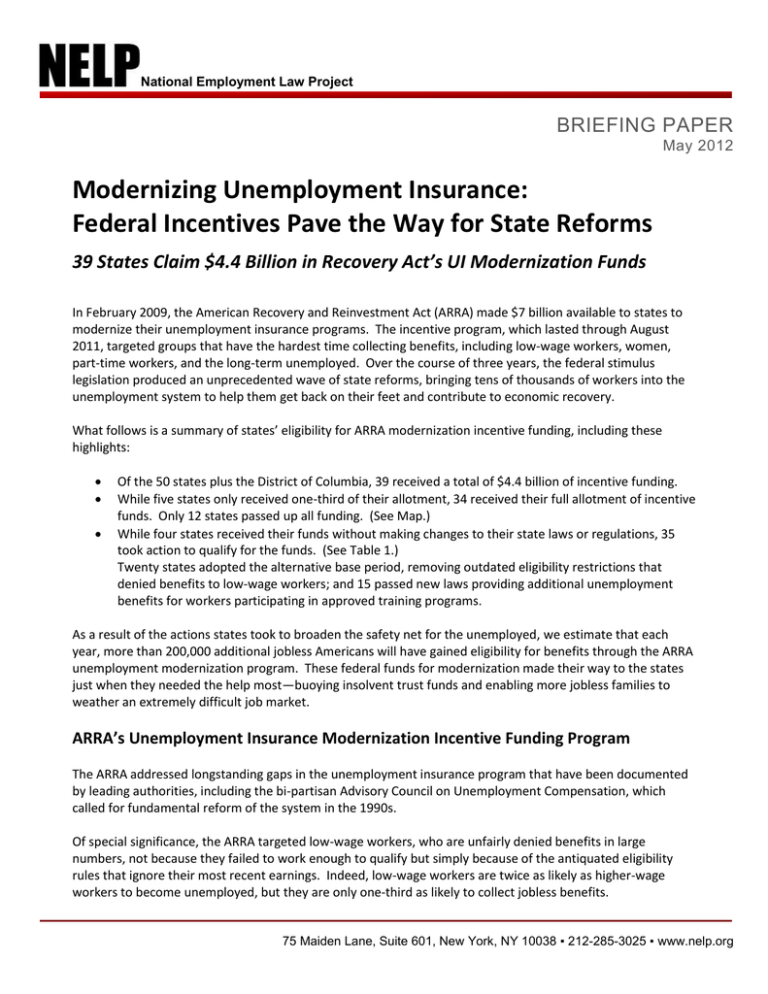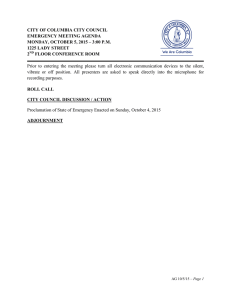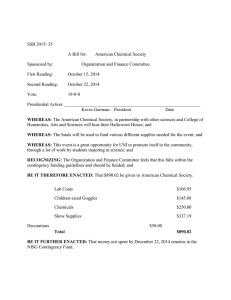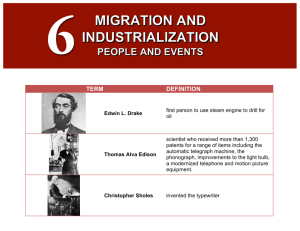Modernizing Unemployment Insurance: Federal Incentives Pave the Way for State Reforms
advertisement

National Employment Law Project BRIEFING PAPER May 2012 Modernizing Unemployment Insurance: Federal Incentives Pave the Way for State Reforms 39 States Claim $4.4 Billion in Recovery Act’s UI Modernization Funds In February 2009, the American Recovery and Reinvestment Act (ARRA) made $7 billion available to states to modernize their unemployment insurance programs. The incentive program, which lasted through August 2011, targeted groups that have the hardest time collecting benefits, including low-wage workers, women, part-time workers, and the long-term unemployed. Over the course of three years, the federal stimulus legislation produced an unprecedented wave of state reforms, bringing tens of thousands of workers into the unemployment system to help them get back on their feet and contribute to economic recovery. What follows is a summary of states’ eligibility for ARRA modernization incentive funding, including these highlights: Of the 50 states plus the District of Columbia, 39 received a total of $4.4 billion of incentive funding. While five states only received one-third of their allotment, 34 received their full allotment of incentive funds. Only 12 states passed up all funding. (See Map.) While four states received their funds without making changes to their state laws or regulations, 35 took action to qualify for the funds. (See Table 1.) Twenty states adopted the alternative base period, removing outdated eligibility restrictions that denied benefits to low-wage workers; and 15 passed new laws providing additional unemployment benefits for workers participating in approved training programs. As a result of the actions states took to broaden the safety net for the unemployed, we estimate that each year, more than 200,000 additional jobless Americans will have gained eligibility for benefits through the ARRA unemployment modernization program. These federal funds for modernization made their way to the states just when they needed the help most—buoying insolvent trust funds and enabling more jobless families to weather an extremely difficult job market. ARRA’s Unemployment Insurance Modernization Incentive Funding Program The ARRA addressed longstanding gaps in the unemployment insurance program that have been documented by leading authorities, including the bi-partisan Advisory Council on Unemployment Compensation, which called for fundamental reform of the system in the 1990s. Of special significance, the ARRA targeted low-wage workers, who are unfairly denied benefits in large numbers, not because they failed to work enough to qualify but simply because of the antiquated eligibility rules that ignore their most recent earnings. Indeed, low-wage workers are twice as likely as higher-wage workers to become unemployed, but they are only one-third as likely to collect jobless benefits. 75 Maiden Lane, Suite 601, New York, NY 10038 ▪ 212-285-3025 ▪ www.nelp.org To remedy these and other inequities that have long plagued the unemployment insurance program, the ARRA created financial incentives for states that adopt a set of proven policy reforms. To qualify for the first one-third of the ARRA’s incentive funding, a state was required to adopt the “alternative base period,” which allows workers to count their recent earnings when needed in order to qualify for unemployment benefits. To qualify for the remaining two-thirds of the ARRA incentive funding, states were provided a menu of options that target other major groups who fall through the cracks of the unemployment system, including part-time workers, women with families, and the long-term unemployed. Specifically, to qualify for the additional ARRA incentive funds, a state was required to provide benefits to workers in a least two of the following four categories: Part-time workers who are denied benefits because they are required to actively seek full-time employment; Individuals who leave work for compelling family reasons, specifically including domestic violence or sexual assault, caring for a sick family member, or moving because a spouse has relocated to another location for employment; Workers with dependent family members who would qualify for $15 or more in weekly benefits per dependent (up to a total of $50) to help cover the added expenses associated with dependent care; Permanently laid-off workers who require access to training in order to improve their skills with the help of an extra 26 weeks of additional unemployment benefits. The states had until August 22, 2011, to submit their applications to the U.S. Department of Labor to certify that their laws or regulations complied with these specific provisions of the ARRA’s incentive funding program. For more information on the unemployment insurance modernization program, click here. Strong Start in 2009 Yields Reforms in 28 States With the enactment of ARRA in 2009, 28 states took action to reform their UI program to qualify for incentive funding, often with strong bi-partisan support. These states represented every region of the United States: the Western states (Alaska, California, Hawaii, Idaho, Nevada, Oregon), the Central states (Colorado, Kansas, Montana, Oklahoma, South Dakota), the Midwest (Illinois, Iowa, Minnesota, Wisconsin), the South (Arkansas, Georgia, North Carolina, Tennessee), and the Northeast (Connecticut, Delaware, Maine, Massachusetts, New Hampshire, New York, New Jersey, Vermont, West Virginia). Major Bi-Partisan State Reforms Continued in 2010-11 In 2010, eight more states (Alaska, Maryland, Nebraska, Rhode Island, South Carolina, South Dakota, Utah and the District of Columbia) adopted the UI modernization reforms. In 2011, one additional state, Washington, qualified for incentive funds by expanding eligibility in its UI program. There was clearly bi-partisan support for the federal incentive program. For example, in South Carolina, Nebraska, South Dakota and Utah, the measures passed Republican legislatures with the support of their Republican governors (Alaska’s provisions were adopted by regulation). Indeed, more than half the Republican governors in the nation signed legislation that qualified their states for federal incentive funding. The states that adopted reforms in 2010-11 ran the gamut from states with no reforms in place before ARRA, to states that only needed to enact one additional reform to qualify for their full incentive. Utah adopted the alternative base period and claimed one-third of its incentive funding. Maryland, Nebraska, and South Carolina each adopted a package of reforms that qualified them for their full incentive. Alaska, the District of 2 Columbia, Rhode Island, South Dakota, and Washington were all eligible for one-third of their incentive in 2009. They made additional changes in 2010 or 2011 to tap their full incentive grant. Federal Incentive Funds Produced Key State Reforms In the three years that the incentive funds were available, they were successful in spurring states to modernize their programs to meet the needs of today’s diverse workforce. These funds prompted 39 states to make nearly 100 reforms to their UI programs.1 Before the ARRA incentive, only 19 states had in place the alternative base period, which is the key policy reform expanding eligibility to low-wage workers. Now, that number has more than doubled to 39 as a direct result of the Recovery Act funding. Fourteen additional states expanded coverage to part-time workers, bringing the total number to 29. In addition, 15 states elected to provide extra UI benefits for long-term unemployed workers enrolled in state-approved training programs. Additionally, to varying degrees, numerous states extended UI eligibility to workers whose job loss was due to compelling family circumstances, with 13 states adding coverage for domestic violence, 14 choosing to add coverage to care for a sick family member, and 16 extending coverage to a relocating spouse. Although the provision to boost benefits for workers with dependents was less popular, the federal incentive funds still doubled the number of states providing a dependent allowance, from 4 up to 8 states. 1 In order to qualify for their incentive funds, these states took one of more of the following actions: of passing new UI legislation; amending current UI legislation; modifying its UI regulations; or clarifying it procedure to ensure interpretation of the law meets the ARRA requirements. 3 Table 1: Federal Unemployment Insurance Incentive Funding State Reforms, April 2012 Federal Unemployment Insurance Incentive Funding State Reforms State Compelling Family Reasons ARRA Year Enacted Alabama Alaska Arizona Arkansas California Colorado Connecticut Delaware District of Columbia Florida Georgia Hawaii Idaho Illinois Indiana Iowa Kansas Kentucky Louisiana Maine Maryland Massachusetts Michigan Minnesota Mississippi Missouri Montana Nebraska Nevada New Hampshire New Jersey New Mexico New York North Carolina North Dakota Ohio Oklahoma Oregon Pennsylvania Rhode Island South Carolina South Dakota Tennessee Texas Utah Vermont Virginia Washington West Virginia Wisconsin Wyoming Total 2009/2010 2009 2009 2009 2009 2009 2010 2009 2009 2009 2009 2009 2009 2009 2009/2010 2009 2009 2009 2010 2009 2009 2009 2009 2009 2009 2009 2010 2010 2009/2010 2009 2010 2009 2009/2011 2009 2009 N/A Amount (millions) $0.0 $15.6 $0.0 $60.0 $838.7 $127.5 $87.8 $21.9 $27.6 $0.0 $220.3 $30.5 $32.3 $301.2 $0.0 $70.8 $69.0 $0.0 $0.0 $28.2 $126.8 $162.7 $69.4 $130.1 $0.0 $0.0 $19.5 $43.6 $76.9 $31.4 $206.8 $39.0 $412.7 $205.1 $0.0 $88.2 $75.9 $85.6 $0.0 $23.5 $97.5 $17.6 $141.8 $0.0 $20.3 $13.9 $62.8 $146.6 $11.1 $133.9 $0.0 $4,374.1 Full Incentive ABP Yes Enacted Yes Yes Yes Yes Yes Yes Part-Time Enacted Enacted Effective 2011 X Enacted Enacted (Fix) X Enacted X X X X X Enacted X Enacted Enacted (Fix) Enacted Yes Yes Enacted Enacted Enacted (Fix) Enacted (Fix) X O X Enacted Enacted Enacted Enacted X X X X X No Yes Yes X Enacted (Fix) Enacted Yes Yes Yes Yes X Enacted Enacted Enacted No Yes No Yes No Yes Enacted X X X Enacted X Enacted Spouse Relocates Illness & Disability Enacted X Enacted X Enacted (Fix) Enacted (Fix) X X X X Enacted X Enacted Enacted Enacted Enacted Enacted X Enacted (Fix) X Enacted (Fix) Enacted (Fix) Enacted Enacted Enacted Enacted Enacted Enacted X Enacted (Fix) Enacted Enacted Enacted Enacted Enacted X Enacted X X X Enacted (Fix) X Enacted (Fix) O X Enacted (Fix) Enacted (Fix) X O X O O X O X Enacted (Fix) Enacted (Fix) Enacted (Fix) X Enacted (Fix) Enacted (Fix) Enacted (Fix) X X X Enacted (Fix) O X X X Enacted X X Enacted X Enacted (Fix) Enacted (Fix) Enacted (Fix) X Enacted X O Enacted Enacted (Fix) X Enacted (Fix) Enacted (Fix) Enacted (Fix) Enacted (Fix) X X O X Enacted (Fix) X X Enacted X Enacted Enacted X Enacted X X Enacted X Enacted Enacted X Enacted X x X Enacted X Enacted Enacted (Fix) X Enacted Enacted (Fix) 32 26 24 X 39 Domestic Violence Enacted X X X Enacted (Fix) Enacted Enacted Enacted X Enacted (Fix) X Enacted (Fix) Enacted (Fix) Yes Yes Yes Yes Yes Yes Yes Yes Dependent Allowance X Yes Yes Yes Yes Yes Yes Yes No Yes Training 29 16 8 Key: X = Provision enacted pre-ARRA O = Provision exists in some form, although not ARRA-compliant Fix = Legislative technical fix 4






